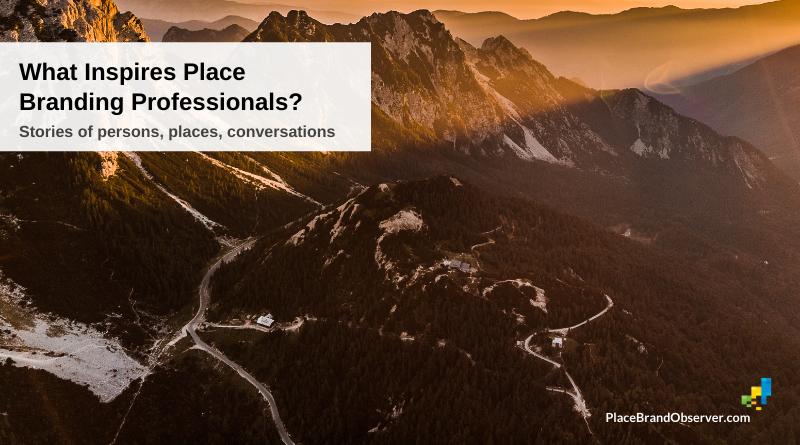Place branding professionals get to meet new people and explore new places all the time. Sometimes with truly inspiring – if not life-changing – encounters and invaluable lessons learned. Following Natasha Grand’s lead, in our latest panel of place branding specialists we asked:
What have been the most interesting persons, conversations or locations you have come across during your research for a place branding project?
Below the answers (in alphabetical order – highlighted respondents are available for consulting, research, or as speakers).
Andrew Hoyne
Hoyne Design / Speaker profile
One of the most interesting examples of a place brand in Australia is the one for the new Maroochydore CBD. Maroochydore was traditionally nicknamed ‘God’s waiting room’ as a place for retirement which lacked commercial focus. However, the new brand (launched a few years ago) positioned Maroochydore as a smart city of the future and a breeding ground for business success.
While the process is decades-long, the positioning has already had a major influence on private and government investment, positive economic impact, and growth in surrounding residential development.
With the impact of COVID, many organisations are taking a hub-and-spoke model, moving their offices away from major CBD’s and pursuing high amenity desirable locations with good weather. Maroochydore’s brand has already positioned itself perfectly to take advantage of this new commercial business model.
Christopher Hire
Taiwan is fascinating. Taipei is far more technological than many realise and their use of convenience stores as utility knife post offices. Many Asian cities and countries have eclipsed western nations in their use of the practice, as the west has become increasingly bland and woke (plus cancel culture). Being negative (always against or cancelling) does not boost a brand.
A place brand is in its essence defined by what it is. Not by what it isn’t (negatives). Western media like CNN and national broadcasters have become almost nihilistic in a negative focus, something that doesn’t trouble all Asian countries.
Günter Soydanbay
Soydanbay Consulting / Speaker profile
I make it a priority to read whatever Jeremy Hildreth writes. His approach is quite different than those of other practitioners. He fully immerses himself in specific geographies, living there for an extended period. So, I value how he constructs his perspective.
In terms of the most exciting conversation, there is one that I would like to share with the TPBO community. I am analysing the correlation among universal visitor types and personality traits by using the Five-Factor Model of Personality, which Professor Dev Jani looked into. So my message to those researchers who are drawn into this inquiry: “Feel free to contact me!”
Heather Skinner
Person: Mr Spiros Kaloudis, Managing Director of Corfu Beer, a microbrewery in the North West of the small Greek island of Corfu, has made a point of naming his beers in a way that locates them to the place of production. He has created the Corfu Beer brand for sale in the local market, and the Ionian brand to sell to nearby export markets in the other Ionian Islands. You can read more about the rationale behind these brand naming decisions located to places here.
Conversation: Professor Gregory Ashworth is the person with whom I had the most interesting conversation about place branding. I met him at a conference in Manchester in 2006, and he was so supportive of my forays into this research topic. He was then, as he continued to be throughout his career, concerned that academics provide appropriate theorisation on place branding, and encouraged me to undertake such work in my research. We talked about the distinctions of the subject, and how it was beholden upon us academics to provide the underpinning conceptualisation of this emerging research area. I took great courage from his words, and with my co-author, worked on doing just that. The result of which was the publication a year later of this conceptual paper.
Place: Arillas is a small resort in the North West of the small Greek island of Corfu. Alongside being a traditional holiday resort that attracts British and German tourists looking for the sun, sea, and sand, it has also organically developed a niche spiritual tourism market which offers a range of organised activities. Events and festivals are organised by six spiritual centres/clubs in the village and the further three located nearby.
However, the behaviour of some of the spiritual tourists and the disruption caused by some of the events and festivals are highlighting Arillas as a contested space, especially during summer when the usually 400-500 residents receive an influx of visitors to the resort’s 1000-1200 tourist bed capacity. You can read more about the tensions between the local Corfiot community, expatriate residents, tourists, and the spiritual Sanyassin Community in this article. It explores the notion that while there are many positive impacts of spiritual tourism to resort, these should not be pursued at the expense of one group of stakeholders over another.
Jeannette Hanna
Trajectory Brand Consultants / Speaker profile
Congress Heights is one of Washington, D.C.’s oldest African-American communities and also one of its most perpetually under-served, economically challenged neighbourhoods. Yet, led by several inspiring community organisers including Monica Rae, this community’s indomitable resilience and pride has sparked its “Soul of the City” narrative.
Community workshops brought together elders, youth, and young professionals to change the economic tide for the area while preparing against the challenges of gentrification (listen to an interview with Monica Rae here).
Juan Carlos Belloso
I have had all types of interesting conversations with people from many places that are not (consciously) involved in the place branding field. Especially with historians and, in general, elder people who know about a place and can share great stories with you.
Although I love every place I have been involved with, the most interesting are usually those that you don’t know much about or where main associations usually come through stereotypes and those with a rich cultural heritage and tradition. Just to mention a few, I was inspired by the work I did in Siberia, Georgia, Morocco, Argentina and China.
Natasha Grand
My best memories – and the most useful research findings – come from conversations with ‘salt of the earth’ people: a dedicated and serious cheesemaker, a proud head of a village council, a creative and energetic local tour guide.
I like visiting ‘boring’ places – where seemingly nothing happens day in and day out, where there is not too much to report – they exude a quiet assurance, certainty, and peace. One such town is the Lev Tolstoy, an eponym of the extraordinary writer who had passed away there in a quiet corner of southern Russia.
Todd Babiak
One of the sorts of questions I like to ask, in the research phase of a place branding project is, “What would break your heart if you had to leave? What would you miss the most?”
Most people, in most places, answer this question in the same way, and it leads to cultural specificity, which is what I’m after. One sunny afternoon in Alice Springs, Australia, I asked an Aboriginal elder these sorts of questions.
He wasn’t being difficult but he didn’t answer. He couldn’t answer. He said, again and again, “I wouldn’t leave.” He chose not to imagine himself leaving his land. “This land is me. It’s my people. I can’t leave myself.” While he didn’t answer the question in the usual way, it was a wonderful illuminating answer.
Tom Buncle
Yellow Railroad Consulting / Speaker profile
Simon Anholt: for his moral-political approach, whereby he links the power of place branding to social justice, economic development, and poverty reduction, especially in his book “Brand New Justice”.
Glasgow: For its “People Make Glasgow” campaign, which was truly democratic and well-informed because it invited citizens and external commentators to define what Glasgow meant to them. By securing their participation, Glasgow not only found a simple but powerful expression of the city’s spirit but, critically, it also secured residents’ emotional buy-in to the way the city talks about itself in a way few destination brands ever do.
Eduardo Oliveira
I met José Filipe Torres, CEO of Bloom Consulting during the 2nd year of my PhD studies. Back in 2013, I was investigating the role of place branding in strategic spatial planning. His wise words on how academics could better support the work of practitioners have influenced the way I understand academic writing, at least within place branding.
Writing that must be accessible, jargon-free, and provide sound recommendations for practice. I also remember how he was ‘complaining’ about the lack of communication between researchers and consultants. This conversation resonates with a recent exchange of ideas with Malcolm Allan, President of Bloom Consulting. Malcolm reinforces the need for tighter relations between academics and practitioners in the broad domain of place branding in the face of grand societal challenges.
Gustavo Koniszczer
For the creation of Brand Peru, as part of the process, we decided to visit different places across the country (in 2009). We split into groups, and I went to Machu Picchu. For sure, one of the most incredible experiences I have ever had. The very moment you see the site in all its magnificence, you feel overwhelmed, and a supernatural sensation flows inside your body.
For the same project, we interviewed government officers, business people, and culture representatives. As part of the research, we had a chat with Mario Vargas Llosa, who was elected a few years later for the Nobel Prize in Literature. For all of us who had read his books, it was beautiful to talk with him. During the conversation, he came up with an image that we used as the basis for the positioning: “Peru is like a closet full of drawers, each one containing a little surprise.”
Finally, when we first visited Haiti as part of the process to create its country brand, in 2018, we needed to get in contact with representatives from all components of the Haitian society. The most intriguing one was voodoo, a typical Haitian cultural manifestation. We finally met with a ‘Voodoo Master’ who explained the real sense and meaning of this way of life, which is far from what movies usually show. The conversation was in creole, one of the official Haitian languages.
Inga Hlín Pálsdóttir
When I was starting to look into place branding (back in 2003) while I was studying in Scotland, I fell for everything that New Zealand was doing at the time. I later came home to Iceland and started working on place branding for the government, and I still kept looking at what New Zealand was doing and used it many times as a best case.
I thought it was interesting how they were able to join forces throughout the governmental agencies and give a clear focus in messages and with the fern logo. The tourism campaign and the brand 100% Pure New Zealand have been such an inspiration, especially being able to stick for such a long time. It was very interesting and such a pleasure to meet Rebecca Smith, Director of the New Zealand Story in London at the City Nation Place conference in 2017, and to learn more about what they are doing and the way she is working. One day I will go there!
Jaume Marín
Two persons I have found very inspiring are Jordi San Eugenio and Robert Govers. Their book Imaginative Communities is excellent.
José Pablo Arango
In any place branding-related conversation, the most interesting conversations I found always to be those with what I’d call the unfamiliar local heroes.
Previous questions answered by the panel here.
You’d like to ask the panel a question? Get in touch!
Which experiences or places have inspired and encouraged you, in the context of place branding? We’d love to hear your story!











